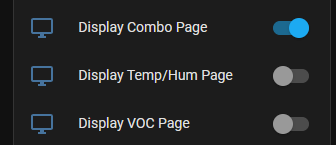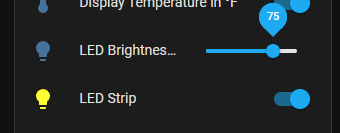ESPHome yaml files for AirGradient devices to maintain the research and accuracy of AirGradient sensors, while also gaining the benefits of ESPHome/HomeAssistant for easy to use switches, buttons, configurations, and dashboards. Maintains the ability to also send data to the AirGradient Dashboard, which can also be disabled/removed to keep all data local.
- Remove substitution line such as
config_version: 2.0.5from the main file, as this has been moved into the board package file - Updated to 4.0.0 versions, skipping 3.x to avoid confusion with current AirGradient official firmware
- Support for ESPHome 2024.6 and later
- Added extended timeout for API upload on ONE and OpenAir models to reduce reboots
- Applied correction algorithms for PM2.5 provided by AirGradient
- Updated API upload to follow current structure including both raw and corrected values
- Moved config_version substitution into the board package so it can be updated without manual change to main config file. Please remove the line starting with
config_version:from your personal files - Split captive portal config to a separate package. Can be removed if not using the portal or if defining wifi networks in your config file, which results in a small memory savings
- Removed safe_mode package by default. Very few use cases for it
- Added commented out packages for extended_life configs to make it easier to enable if desired
- Added commented out package for SHT30 temp sensor in AG Pro file to make it easier to switch to if desired
- Added new sensor options for raw values for PM2.5, temp, and humidity in some device configurations, and added AirGradient provided correction algorithms to the standard sensors
- AG DIY Basic display config changed to same font as other models, downloading from gfonts instead of using local file
Many added features can be found in HomeAssistant by going to Settings>Devices and selecting the AirGradient device. Alternatively, add web_server: to the config file to enable a built-in web server on the AirGradient device (No recommended for devices based on the D1 Mini ESP8266)
-
Compact single page display by default with all relevant sensor readings
-
Display Contrast slider to dim the display
-
Enable different pages of information to be shown on the OLED display, or leave the default of a single page with all relevant information
-
Button to initiate a SenseAir S8 CO2 Calibration on demand
-
Switch to enable or disable SenseAir S8 CO2 sensor Automatic Baseline Calibration (ABC)
-
Button to view the current S8 ABC interval (confirm if ABC is disabled or enable, which defaults to every 7 days) View ESPHome logs to see the output of this button
-
Switch to disable LED output on AirGradient ONE model
-
Brightness slider to adjust intensity of AirGradient ONE LED
-
Switch to toggle display between Fahrenheit and Celsius and persist between reboots
-
Switch to enable or disable uploading to AirGradient Dashboard via API (Choose to keep data local or also send to AirGradient)
-
Utilize hardware configuration buttons on AirGradient Pro v3.7 and higher
- Short press (Less than 1 second) - Toggle between F and C on display
- Long press (More than 1 second, less than 5) - Trigger manual CO2 calibration
-
Leverage automation in HomeAssistant to turn on the "Blank" page and turn off all other pages to effectively disable the display output. Could also turn off the LED strip or set Brightness to 0 to eliminate output while still collecting sensor data
- In ESPHome web interface, click New Device. Give any name. Select any model of board, and click Skip on the final page to not install at this time. Click Edit on the new entry and replace with the contents of the .yaml file for your model.
- Alternatively, copy the .yaml file from the main folder for your model in this repo and place it in the
configfolder of your ESPHome. - Make any desired changes to the substitutions to name the devices for your use case
- Install to the device using one of the ESPHome options.
Note: by default ESPHome only syncs remote repositories that the packages are referencing once per day, so if changes are made to the repository, you may not get the updated config for up to 1 day after it is published. You can remove the contents of the folder config/.esphome/packages to force it to update sooner
Note: setting
add_mac_suffix: "true"allows for multiple devices on your network at the same time and report as unique entries even if yourname:field is duplicated, but it can cause ESPHome to not detect devices as Online after installing, since ESPHome is looking for only thename:field and the actual device name has the MAC address added to the endOne way to resolve this is to change
add_mac_suffix: "false"so the device name will match exactly. If you have multiple devices, make sure to change thename:field to be unique for each deviceAnother alternative is to add a static IP to the wifi configuration and configure ESPHome to ping the device by IP instead of hostname
Dashboard status light not working across subnets/zones · Issue #641 · esphome/issues (github.com)
Example for static IP
wifi: ssid: !secret wifi_ssid password: !secret wifi_password manual_ip: static_ip: 192.168.1.121 gateway: 192.168.1.1 subnet: 255.255.255.0 dns1: 192.168.1.1
Install a compiled file to your device all with just a browser and USB cable, no ESPHome install required.
Save the appropriate .bin file and go to https://web.esphome.io/ in your browser to connect your ESP device and send the .bin file to it
In some cases, the device may encounter errors using the web flash tool. Steps to put the device in a special boot flash mode can be found here: https://forum.airgradient.com/t/airgradient-one-not-working-after-flashing-with-arduino/1326/4
The full_config folder contains a single yaml file per model that contains the full standalone configuration, created by the esphome config command. This adds in all of the optional parameters, so is much longer than the minimum configuration, but the single file contains all needed information to be completely independent from this repo.
Copy the full config file to your personal ESPhome config file and customize as desired, then install to your device.
If some sensors are not showing valid readings after installing or upgrading, please remove the power cable from the device entirely for 5-10 seconds, then reconnect. Many issues are resolved with a full power reset, as the software reset does not fully clear some situations.
If all original sensors (PMS5003, Senseair S8, SHT4x) are connected, configuration files should be ready for use.
If some sensors are not installed, comment or remove the associated sections under packages:
The PMS5003 sensor by default collects readings every second. Since this device has a limited lifespan, it is possible to extend the life by collecting readings less frequently, although this could impact the accuracy of the readings collected, since there will not be constant airflow through the device when the fan shuts down. To collect readings every 2 minutes, change the line for the pms5003 sensor to sensor_pms5003_extended_life.yaml
See PMSX003 Particulate Matter Sensor — ESPHome for more information
To add your WiFi SSID and password, add your SSID and password information, per ESPHome specifications
wifi:
ssid: NachoWiFi
password: 123456123456By default, packages are referencing this GitHub repository, allowing you to do a new Install from ESPHome dashboard to get the latest modifications without downloading other files, but does require an Internet connection. If you wish to have more control over modifications or only reference local files, copy the packages folder to your local ESPHome folder in a packages subfolder and replace github://MallocArray/airgradient_esphome/packages with !include packages
# Example
board: github://MallocArray/airgradient_esphome/packages/sensor_s8.yaml
# becomes
board: !include packages/sensor_s8.yamlRather than download an individual package and update the reference to it, you may also use the Extend option to make minor modifications without editing the packages file. This only works for items with and id: defined
Example: adding this to the main file for your device will change the pin number in the config_button package, while maintaining all other settings defined in the package
binary_sensor: - id: !extend config_button pin: number: D7
It is also possible to copy the contents of a package file and paste it directly into your YAML file. Do note that sections cannot be duplicated, so if multiple sections like interval are pasted in, they must be combined into a single entry when using this method.
Several additional packages are available in the packages folder that can be added or removed as needed. See the Packages page for more information about available options.
MQTT support has been mentioned in the AirGradient forums several times. ESPHome supports this by adding a few lines to the main yaml file. Add the relevant information for your configuration. Read more about it here: https://esphome.io/components/mqtt.html
Several more features are planned to be added to this repo
- Explore options for disabling display/LED during certain times (May be differed to HomeAssistant Automation)
- Standardize font on AirGradient Basic display to match Pro






